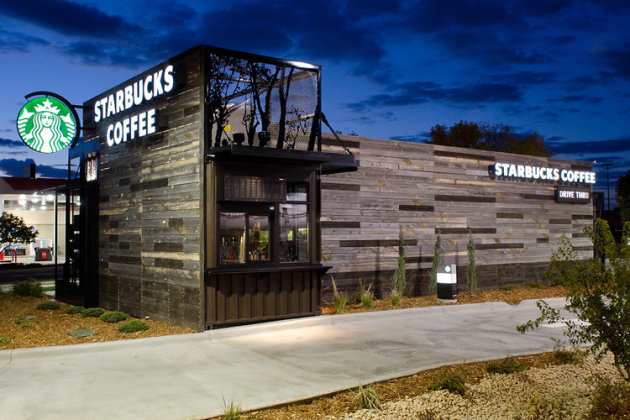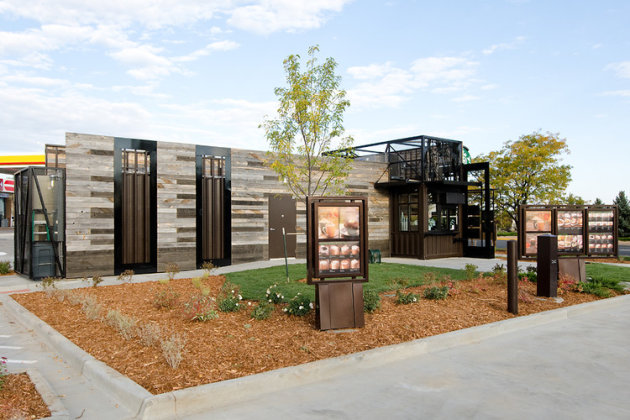A new style of smaller, LEED-certified Starbucks may touch down near you soon. It's all part of a plan to evolve the coffee giant's business
From: http://www.fastcompany.com/
This week in Colorado, Starbucks opened a store unlike any before it. There are no leather chairs or free power outlets. In fact, there’s no space for the customer at all. Starbucks has reimagined the coffee hut as a “modern modular,” LEED-certified drive-thru and walk-up shop. The building was constructed in a factory and delivered from a truck, but its facade is clad in gorgeous old Wyoming snow fencing. As diminutive as the shop may be, its designer wants drivers to pass by and ask “What is that?” only to conclude that, oh, “it’s art.”
WHAT WOULD THE FLANNEL-WEARING 1990s STARBUCKS SAY?
It’s hard to remember the Folgers era, before Seattle’s grunge scene and coffee culture invaded the U.S. In retrospect, the shift seems inevitable. Coffee, popularized during the industrial revolution, just got bigger as the Internet revolution began. Today we all know that a laptop is near-useless without an Internet connection and a warm cup of caffeine by its side. Yet Starbucks’s Arthur Rubinfeld, the now president of global development but architect by trade (and Co.Design 50), remembers a different story--one where Starbucks wasn’t a trenta-sized juggernaut, but a longshot beverage company hoping to sell America on frou-frou coffee. “When I joined in ‘92, we were under 100 stores. And we had an understanding that espresso-based beverages were on trend. We knew this from the loyalty of our customer base at the time, but our category--speciality beverages--was not in itself a business driver,” Rubinfeld tells me. “At that point it was about establishing the American idea of the coffee house. Hundreds and hundreds of years old in Europe, it was mostly about community.”
WHAT WOULD THE FLANNEL-WEARING 1990s STARBUCKS SAY?
It’s hard to remember the Folgers era, before Seattle’s grunge scene and coffee culture invaded the U.S. In retrospect, the shift seems inevitable. Coffee, popularized during the industrial revolution, just got bigger as the Internet revolution began. Today we all know that a laptop is near-useless without an Internet connection and a warm cup of caffeine by its side. Yet Starbucks’s Arthur Rubinfeld, the now president of global development but architect by trade (and Co.Design 50), remembers a different story--one where Starbucks wasn’t a trenta-sized juggernaut, but a longshot beverage company hoping to sell America on frou-frou coffee. “When I joined in ‘92, we were under 100 stores. And we had an understanding that espresso-based beverages were on trend. We knew this from the loyalty of our customer base at the time, but our category--speciality beverages--was not in itself a business driver,” Rubinfeld tells me. “At that point it was about establishing the American idea of the coffee house. Hundreds and hundreds of years old in Europe, it was mostly about community.”
So that community coffee house was crafted into an archetype, the plush-chaired, dark-wooded, Starbucks that we all know today (a European clone so effective that it’s taken a bite out of Europe’s own coffee market). Yet Starbucks still had to win over America city by city in a strategic land war, so they made their way into strip malls and shopping centers, recognizing coffee as an impulsive convenience purchase to complement a trip to the grocery store or post office. Each regional strategy had to be tailored at the city level, but it always started with a convenience-based link. “Chicago is one of the early Starbucks entry points,” Rubinfeld says. “When Starbucks entered in Chicago, it was at the core of office buildings on the way into work. Then it became more ‘where you live work and play,’ and then it became the third place between home and office--the community connection point, the human interaction point that’s so critical.”
Rubinfeld left the company for a bit, and when he came back in 2008 to take his new seat, the world had changed. No one would call Starbucks a risky business model anymore, nor would they dare finger coffee as a fad. 17% of U.S. adults were consuming a gourmet coffee concoction on a daily basis. Today, coffee’s grown bigger than soft drinks--and it has a two-digit market lead over those fizzy beverages.
BUT OTHER THINGS HAD CHANGED, TOO.
Premium coffee had become an addictive enough habit that Starbucks didn’t require the sloppy seconds of grocery stores or business complexes anymore. A frappucino alone could be worth a trip. At the same time, the local omnivore movement was taking off. Laptops no longer just browsed the Internet, they created it. Culture became about content creation and original voice. And the very definition of cool had changed. Flannel-clad rejects were out, but geeks of all types were in. Teens were wearing backpacks on two shoulders and caring about the environment.
Coming back in 2008, Rubinfeld tied all future store designs with the company’s Shared Planet Initiative, which impacted everything from Starbucks’s practices with farmers to how their stores dispose of refuse. “Once that connection to our mission statement, our soul if you will, was established, that became the go-forward design foundation for our stores, along with one additional very important element, and that is being locally relevant.” But one very big challenge remained.
“HOW DO WE DO THAT WHEN WE’RE OPENING A LOT STORES WORLDWIDE?”
This was a question that Rubinfeld posed to Starbucks’s 14 architectural offices around the world. You see, Starbucks doesn’t hire out their building design. They conceptualize all stores from within. And what resulted was the greenlighting of a series of coffee shops that are absolutely stunning, highly individualized, sustainably idyllic flagships that easily challenge Apple’s best stores in terms of pure chic.
One particular flagship was built right in Seattle, using Starbucks’s reclaimed shipping containers along with prefabricated components. And while Rubinfeld admits that it’d have been cheaper just to ditch those shipping materials altogether, he liked the statement. It was experimental, green, and gorgeous. It was ostentatious and responsible at the same time.
Starbucks, of course, can’t afford to be totally idealist. They still have market challenges of their own and, sooner or later, there are only so many large coffee houses you can build and expect profitability. Rubinfeld describes the issue as one of neighborhood-level demand. Starbucks sees countless markets that might exist, but each is a bit too small to sustain a traditional store with larger square footage.
Their new building paradigm--officially labeled a “pilot program”--is a confluence of all these various impulses. The environment. Localism. Market growth. Low-cost, low-risk expandability. And making it all come together is the responsibility of Anthony Perez, a senior concept design manager who envisioned Starbucks’s original prefab store.
“To both build scale while having things be locally relevant, that’s really a designer’s problem to solve,” Perez tells me. “It’s a really, really challenging problem.” But it’s not an impossible one. The core of each of these new, small Starbucks locations will be a prefabricated, modular set of rooms. At a mere 500 square feet, they have just enough space to squeeze in three to five employees along with all of the coffee making apparatuses necessary to execute a full Starbucks menu.
THAT CORE STRUCTURE IS LIKELY EVERY BIT AS GENERIC AS IT SOUNDS.
But around this mass-produced structure, Perez envisioned high-end facades constructed out of local materials (“local” is actually not just jargon in this case, it’s a LEED-certification point in Starbucks’s favor, meaning the material is sourced within a 500-mile radius). These facades exude “craftsmanship,” I’m told, and can be anything from reclaimed lumber to corrugated metals. The entire point is that there’s not one set go-to in this circumstance. The modular frame can become almost anything with a high-end facade tacked on top. (Also of note, LEED will give Starbucks even more points for using signage to label where parts of their facade were sourced from.)
“What we’ve done is standardize the interior,” he explains. “But what we want to be able to do is, as people are going around this prefab, we want the materials on that exterior to feel like it’s part of the local environment.”
Perez sees this facade as both a literal and metaphorical layer to the building that can make a mass-produced corporate product into a relevant place to the community. It even leaves room for “art panels.” Much like coffee shops will hang pieces from local artists on the walls, Perez wants to see these rear illuminated exterior panels serve a similar function--to push individuality and maybe even local artistic voices.
“We’re working with lots of ways to build palettes similar to what we have inside the cafes, but now we have them on the outside,” he explains. “We’re not looking for all the stores to look similar. They’re going to look very, very different around this idea of craft.”
But amidst all of Perez’s rhetoric of “moments of art” and “delight,” you can see the wheels of a multi-billion-dollar corporation spinning underneath. For one, these modern modular buildings aren’t just placed anywhere. They’re placed particularly on the side of the road on which the most locals drive to work. First and foremost, Starbucks knows that whatever else has changed in 20 years, their coffee is still a “convenience-driven product.”
THESE BUILDINGS WILL ALSO GLOW, ENTICING THE BLURRY-EYED CONSUMER IN.
“Our buildings need to be lanterns, beacons of light in some ways,” Perez says. “We’re responding to a palette of darkness. For a good part of the year in most of our markets, most of our business in a drive thru is done first thing in the morning. Instead of having just a few glowing signs and a light in the hallway, is there way to do this to make it a lot more interesting? Actually activating the building in such a way that’s taking advantage of light?” He’s careful to add that they’ll do it in "a very environmentally sensitive way."
Some might see that last tag-on as lip service, but from an awkward set of moments and questions that followed, I inferred that Perez had just spilled the beans on something much bigger. Consider the small, modular locations. Consider the LEED certification. Consider the power savings of a drive-up business that doesn’t need to feed electricity to laptops all day. Starbucks might not just be designing modern modular locations that are off the normal consumer grid--they could be designing low-footprint stores that eventually go off the grid altogether.
Click here to see more photos of An Experimental New Starbucks Store.




Dette er et flott hus, takk så mye for å dele deg bilder. Jeg låste bildene av skuffen tak. Jeg har en skuff taket i min master bedroom jeg fortsatt prøver å finne ut hva de skal gjøre med.
ReplyDeleteFerdighus